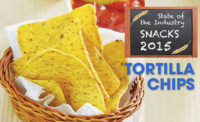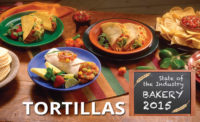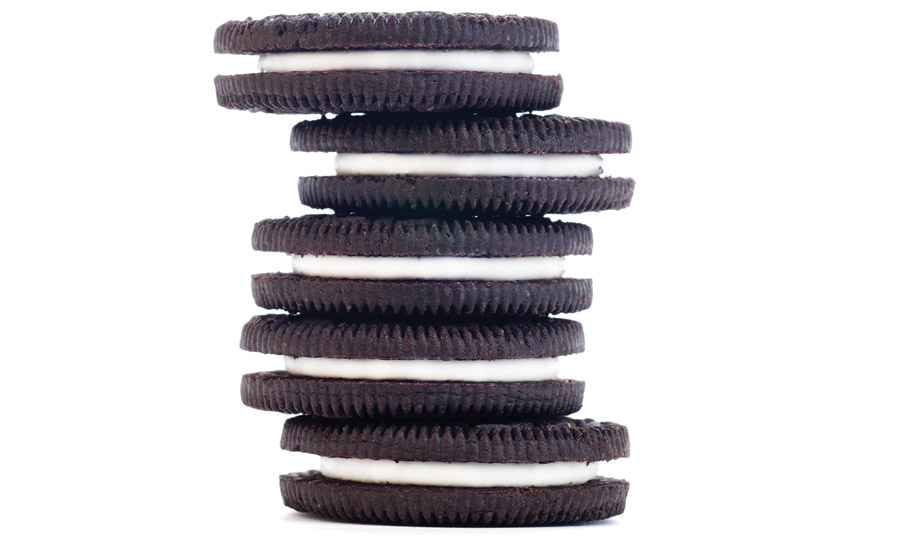Cookies market sports new flavors: State of the Industry 2015





courtesy of General Mills









Despite efforts to eat healthier, Americans still love their sweets. According to “Outlook on the Millennial Consumer 2014,” a nationally syndicated research report published by the Hartman Group, millennials, in particular, “prefer to focus on the delicious things they love to eat,” and their definition of well-being “includes indulgence.” So, when no one is looking–or perhaps even when they are—they enjoy a slice of cake, a piece of pie or a handful of cookies.
Overview | Bread | Tortillas | Sweet Goods | Snack Cakes | Pizza | Desserts | Cookies | Buns & Rolls | Bars
Market data
It’s not surprising, then, that nearly every product category that we generally consider connected to dessert, treats or indulgence—from moderate to unfettered—is up in dollar sales for the past 52 weeks ending April 19, 2015, according to data provided by IRI, Chicago.
The cookie category overall was up only slightly in dollar sales, rising 0.45 percent over the past year. However, because of the size of the category, now valued at more than $7.1 billion, even a small increase translates into sizeable dollar and unit gains for manufacturers—and some specific cookie brands managed significantly higher dollar sales gains than the category average.
 Looking back
Looking back
The big winner in cookies last year was Nabisco’s Oreo brand, owned by Mondeléz International. With sales of $711.4 million, Oreo is the leading retail brand, trailing only private label. Over the past 52 weeks ending April 19, 2015, per IRI, Oreos were up 8.21 percent in dollar sales—and Oreo Double Stuf garnered another $260.7 million (down 4.70 percent), and Golden Oreos took in another $110.7 million (up 4.33 percent).
With a continued focus on the “Wonderfilled” strategy—and associated tie-ins to www.playwithoreo.com—Nabisco continues to launch new Oreo flavors, often as limited-edition SKUs. Seasonal varieties have included colored cookie cream in red and green for the holidays. Other varieties represented a departure from the equity of chocolate cookie with a vanilla cream center, such as the company’s recently launched S’Mores, which includes a graham-style cookie and chocolate-marshmallow cream. An interesting offering for Valentine’s Day was the Red Velvet Oreo with crème flavored like cream cheese.
Flavors like Red Velvet and S’Mores represents an ongoing trend among manufacturers—borrowing flavors from adjacent product categories. Red velvet was traditionally a cupcake and cake flavor, while S’mores is a classic confection combination. Introducing cookies in these iconic flavors might entice consumers of other sweet goods to visit the cookie aisle.
Filled cookies continue to add interest to the category. Pepperidge Farm—the current No. 5 cookie producer—offers Milano Melts, crispy on the outside, completely enrobing an indulgent crème center. Flavors include Dark Classic Crème and Boston Cream Pie, both featuring the classic Milano biscuit cookie, and Vanilla Crème, which features a chocolate cookie.
Other recent offerings in filled or stuffed cookies include The Ultimate STUFT Cookie line from Calabasas Cake & Cookie Co. Varieties include Chocolate Chip with Fudge Brownie filling, Confetti with Birthday Cake filling, Fudge Brownie with Peanut Butter & Pretzel filling, and Sugar with Lemon Bar filling.
Mondelez International also saw strong sales with its breakfast-daypart Nabisco belVita Biscuits—a 34.10 percent increase in dollar sales for the 52 weeks ending April 19, 2015, per IRI, to hit $193.5 million. BelVita is a true category hybrid, combining the convenience and flavor profile of cookies with the nutrition of a breakfast bar, and typically shelved in the cookie aisle. Line extensions this past year included belVita Bites and a new flavor, Cranberry Orange, in the original crunchy line.
Other strong performers outside of the top five cookie brands over the past 52 weeks include the Kellogg Co.’s Keebler brand Chips Deluxe, up 56.42 percent in dollar sales to $102.3 million. Campbell Soup Co.’s brand Pepperidge Farm Milano cookies were up 10.4 percent, hitting $132.6 million. The Milano line has expanded through the years to include varieties like Milk Chocolate, Mint, Double Chocolate, Orange, Raspberry and Dulce de Leche. Like Nabisco and its Oreos, Pepperidge Farm has also introduced a series of limited edition Milano varieties, including Candy Cane around the holidays.
Although still a relatively small category, the frozen cookie-dough segment has shown rapid growth. This $17.5 million category saw sales jump 246.68 percent over the past year. Although most brands had sales with an upward trajectory, the category’s growth was due primarily to the entrance of Nestlé’s Toll House cookies into the frozen arena. Nestlé Toll House introduced four varieties of frozen cookie dough this past year: Chocolate Chip, Peanut Butter Chocolate Chip, Oatmeal Raisin and Double Chocolate Chip.
At first, it may seem counterintuitive that a more labor-intensive cookie product form is on-trend. However, frozen cookie dough fits several strong consumer desires, including the convenience and flexibility of baking only the exact desired number of cookies.
It is also a clean-label gambit, notes Jen Laska, CEO, Jen & Joe’s Cookie Dough, Los Angeles. “Consumers want better ingredients,” she says. Because the company sells its ready-to-bake cookies frozen, real eggs and butter can go into the mix. The company offers several flavors of traditional cookies—as well as the daring mix of White Chocolate Wasabi.
Looking forward
Next steps for cookies will likely align with several key trends. Flavor and form innovation has proven successful. Expect to see more flavor inspirations from other dessert categories, like pies, cakes and cheesecakes, including formulation dynamics that translate into a more-indulgent experience.
Manufacturers are using limited edition flavors and products to create some excitement around a brand while simultaneously performing some selective test-marketing. New flavors, by their nature, can generate excitement—particularly in brand-loyal consumers. The implied short supply of a “limited edition” item is part of the appeal and makes finding such cookies a bit like a treasure hunt. Consumers are more likely to try these flavors and—just as importantly—to engage people on social media about them.
As cookie manufacturers also find inspiration in the candy aisle, expect possible flavor innovation around unexpected flavor pairings. Premium chocolate bars are now available with inclusions like chile peppers and superfruits, as well as interesting flavor accents ranging from lavender to smoked salt and stout beer. Adventurous Millennials are open to new flavor combinations and crave variety, and cookies offer an enticing—yet familiar—canvas for exploration. Salty-sweet and even savory notes could build interest.
Beyond flavor innovations, expect clean-label efforts to continue, simplifying ingredient statements and going non-GMO. We have seen major players across bakery make announcements regarding their intent to remove ingredients that have a negative image in the minds of consumers. In February, Nestlé announced it would remove artificial colors and flavors from all of its candy bars by the end of 2015. And in May, Panera Bread issued its “No-No” list of unacceptable ingredients, including artificial colors, preservatives, sweeteners and flavors.
Other perceived better-for-you formulation rubrics to keep tabs on in cookies include gluten-free and it’s aspirational big brother, free-from (free from all major allergens). The category is also starting to see more concrete nutritional moves through use of ingredients like fruit, nuts and seeds, with forward-thinking manufacturers perhaps taking a page from the success snack and nutritional bars continue to see at retail.
These dynamics are all at play in the successful Nestlé belVita breakfast cookies from Mondelez, along with the similar products that have hit the market from Post Foods and General Mills, which introduced Honey Bunches of Oats Breakfast Biscuits and Nature Valley Breakfast Biscuits, respectively, within the past year.
And thanks to federal guidelines mandating whole-grain-rich formulations for school-lunch programs, ingredient suppliers have been working hard to make whole grains taste better than ever—whole grains that will continue to go into products designed to penetrate into consumer demographics not typically prone to purchasing cookies.
Consumers want it all. They want exciting flavors. They want clean labels. They want indulgence. And a largely untapped segment also wants better-for-you cookies.
Overview | Bread | Tortillas | Sweet Goods | Snack Cakes | Pizza | Desserts | Cookies | Buns & Rolls | Bars
Looking for a reprint of this article?
From high-res PDFs to custom plaques, order your copy today!












